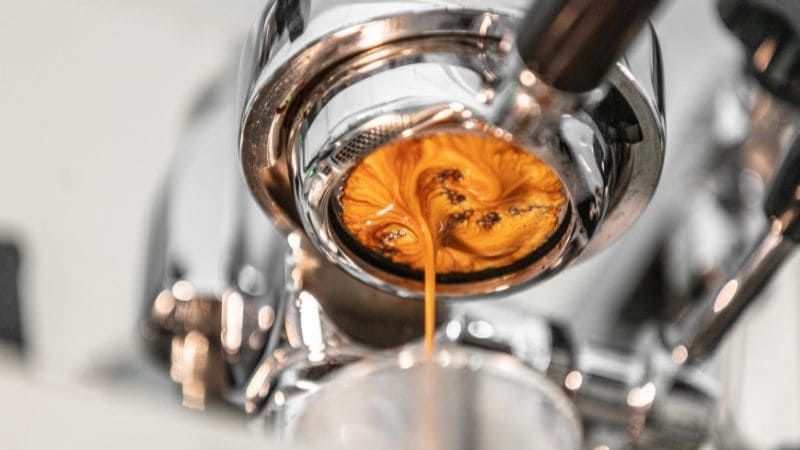
Bottomless Portafilters, also known as Naked Portafilters, have become a necessary component of any quality-oriented coffee shop barista supplies. However, when coffee shoots everywhere throughout the extraction process, the result is nothing but a holy mess.
So I decided to write a complete bottomless portafilter spraying troubleshooting guide to assist my fellow coffee enthusiasts to cope with one.
Bottomless portafilter spraying Reasons & Fixes
The main reason is uneven ground distribution, which causes channeling. Aka the most irritating espresso extraction problems.
Channeling occurs when some regions of the puck allow water to flow easily whereas denser areas will prevent it from passing through.
This is barely noticeable for a regular portafilter, but for a bottomless portafilter, coffee will leak and spray everywhere.
1. Stir the coffee grounds before distribution.
This can be done using a wdt tool, or using a tiny instrument like a needle. The purpose is to separate ground coffee clusters and hard clumps, resulting in a better grind density inside the puck.
You might also want to tap the bottom of the portafilter on the bench. This will assist in deflating any air pockets in the coffee and ensuring the coffee bed is as leveled as it should be.
2. Manual distribution needs to be Perfected
This is an overlooked one, but distributing grounds using your thumb does take time to perfect… Otherwise, if you want to take the guesswork out of it, you can always try using a distribution tool or just upgrade your tamper; most tampers nowadays will come with a built-in distributor to lift off the hassle!
3. Even tamping always produces the best results.
When you tamp the soil, you must spread it uniformly throughout the screen of the basket. So, when tamping, ensure that the tamper is at a 90-degree angle to the filter basket and that even pressure is applied.
Pressure tampers with a diameter of 58.5mm are great for this purpose.
Also make sure you’re using a compatible tamper size. A smaller tamper will not produce even pressure.
4. A coarse grind might also cause a spray
Ensure that the coffee is well ground to the espresso grind size. That said, Excessively fine grind will also produce awful results, especially when combined with a bad dosage.
Check time should be around 18-23 seconds for 14g to fill up 60 ml (depending on the coffee type and brand). If the coffee is coming out too quickly, try adjusting the grind size.
5. Add more coffee to the basket!
If the basket prepping was well done, chances are, it was not filled correctly.
When the amount of coffee inside the puck is insufficient, you will also notice that your espresso golden crema is not forming properly.
If you’re using a bottomless portafilter with a triple basket, use 20 grams of coffee. An amount of ground coffee in the middle that sticks up about a half-inch over the rim will weigh around 18-20 grams, which is an excellent starting point.
6. Why Cleaning Your Portafilter Is Necessary
It is impossible to make an espresso shot taste decent if the portafilter wasn’t properly clean, even with the most incredible and most costly coffee beans.
If you’re a coffee connoisseur, you already know that the essential oils in your coffee beans create the rich Crema on top of your espresso.
However, you might also know that there is a dark side to these oils since they are the source of coffee’s “off” taste over time. In fact, oily residue builds up overtime around the sides of the metal water screen of your espresso machine, eventually blocking the portafilter baskets’ openings and depositing residue in the portafilter spout.
One of the blatant symptoms of this is an awful tasting shot. Fortunately, you can easily remove these deposits with routine cleaning. Here’s how you do it right:
How to deep clean a portafilter
You’ll need:
- Water
- Cleaning Agent
- Detergent
- Scrub
- Brush with a rounded tip
- a squeaky-clean rag
Steps
- Rinse and clean the basket thoroughly.
- The portafilter should be removed and dismantled in this step. You’ll need to remove the spouts and disassemble any extra covers.
- Clean the portafilter inner surface, including the spouts and the body.
- Put the cleaning powder inside a big container, then add water and stir until the powder fully dissolves.
- Soak the portafilter parts for at least 15 minutes in the detergent water. Be careful, you shouldn’t submerge any plastic, Bakelite, or rubber handles. The solution can cause harm to such materials, resulting in rusting.
- To conclude the process, rinse all of the pieces in clean water.
- Repeat the process of scrubbing and then wiping the surface with a clean cloth.
- Check whether any trapped oils are left behind from the soaking process.
- If the portafilter spouts are open slot types, use a tiny round brush to scrape them clean.
- Your portafilter is now ready to use!
Cleaning with water removes most of the grime, but it is inadequate when attempting to remove hard scales from your portafilter.
7. Water flow technical problems:
Powerful early water flow is caused by a broken screen or a defective distribution disc.
Gaggia classic bottomless portafilter spraying
The “crema filter pin” behind the filter basket is undoubtedly broken. It’s a little plastic piece that prevents coffee from shooting out of the portafilter when using a pressurized basket. If the spraying occurs near the grouphead around the sides of the portafilter, then you need to change the group gasket.
That’s not all:
Some of the coffee may also spill out of the bottom of your bottomless portafilter due to poor distribution and an uneven tamp. Uneven distribution of the coffee bed creates pathways for the brewing water to follow that are less obstructed.
This implies that instead of flowing in a continuous stream, water is spat out in jets rapidly, which ultimately creates a mess. On top of all that, a spray that shoots sideways into the portafilters’ skirt might operate as both an extraction bridge and an additional source of drips and pooling.
You could avoid Gaggia uneven distribution issues if you follow my advice above, which is applicable for all espresso machine types.
Uneven coffee extraction signs with a bottomless Portafilter
The ideal espresso extraction has a coloring like “tiger striping,” where darker and lighter shades alternate. If significant parts of your extraction are brighter or darker, you might have coffee in your basket that is being extracted at varying speeds.
This results from an unequal distribution of coffee in the basket, which causes an uneven extraction. Some portions of the shot may be bitter due to prolonged water-to-coffee interaction, while others may be under-extracted and lacking punch.
And while you might hate your bottomless portafilter spraying issues, it actually serves really well to uncover any fault within your espresso making process:
Troubleshooting Espresso Extraction. Bottomless naked coffee portafilters enable the barista to quickly see whether they performed an excellent tamping technique. If the pour only comes out of one spout, either a wrong angle was utilized while tamping, the barista used an insufficient quantity of coffee, or it was tamped unevenly.
Consistency. The ability to troubleshoot espresso shots provides you with a much-needed competitive advantage.
Crema. A bottomless portafilter will provide 50% or more Crema in the hands of an expert barista using fresh espresso beans. (source) Why? The solution is easy.
Your espresso shot will only contact the bottom of your portafilter basket. There were no portafilter bottoms or spouts. This maintains the tiny Crema bubbles that we all want in a great photo, intact and undamaged.
Furthermore, the absence of a spout offers the user greater cup clearance and, in most instances, permits espresso extraction straight into the cup for serving. Of course, brew containers of some form are still required in most situations for to-go cups greater than 12oz.
Taste. More Crema equals more taste. Because it is easy to clean, there will be less contamination from filthy spouts and portafilters. And if there is a buildup of coffee oils on the bottom of the portafilter basket, it should be detected and cleaned.
Training. Naked Portafilters have become a helpful tool for espresso training for the above reasons. Both novice and experienced baristas may now instantaneously and visually identify whether the grind, dosage, and/or technique is on or off.
That’s not all
When you use a bottomless portafilter, you may see the screen of the basket immediately. If your espresso has channels, it will drip into the cup in two or more streams rather than one single, uniform stream.
If your tamping is poor, the espresso will splatter over the countertop and possibly over your clothing, signaling that something is wrong with your method.
Wrap up
A bottomless portafilter is an essential piece of equipment for identifying espresso extraction problems. The spouts are removed, exposing the basket, enabling you to see the whole extraction procedure.
Bottomless portafilters are valuable tools for intermediate espresso lovers wishing to enhance their skills. However, Bottomless portafilters are not recommended for total novices since they may wreak havoc (like spraying) especially if you don’t already have good tamping abilities and proper knowledge on how to use them.
